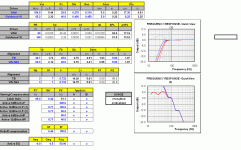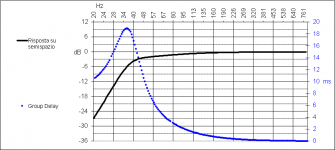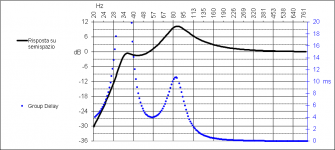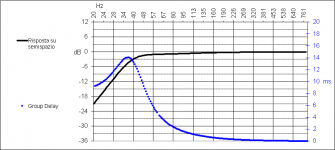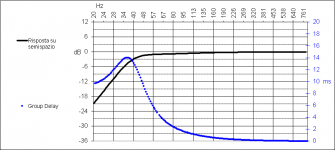Note that your Vas is exactly as I predicted, and the box response in the one I designed will be the same as factory specs. Compare in whatever program you desire with factory specs vs your measured. Often the difference from a strictly Cms change such as this one is minimal, but it depends on the details
Yes you were spot-on
Thanks very much for putting the effort in to do the pdf file for me. I'm just taken with the Onken design and I rather like the look of it too, with the side mounted slots and beveled edges, I think it looks really cool!
OK, perhaps I am using the wrong term. I thought I had heard it be used for this type of alignment.Onkens usually aren't resistive vents
I usually think of resistive vents as being aperiodic or 'stick a rolled sock in it.'
I'm just taken with the Onken design and I rather like the look of it too, with the side mounted slots and beveled edges, I think it looks really cool!
Same here. Why not find a driver that's better suited to a vented enclosure with multiple long vents. It doesn't necessarily have to be "Onken" tuning, as per the spread sheet.
jeff
OK, perhaps I am using the wrong term. I thought I had heard it be used for this type of alignment.
I usually think of resistive vents as being aperiodic or 'stick a rolled sock in it.'
Cal, P10 miniOnkens are not Onkens, they only borrow the vent topology. In a miniOnken the vents are intended to be resistive.
dave
i heard Event transmission line speakers (18W/8535 woofer, Audio Components - Scan-Speak - Classic Line). it's excellent as far as songs aren't bass heavy. (it goes low!) it sucked on L. Cohen's Boogie Street.
we tried SPH-200KE (8" Monacor woofer) in a ported test box with a tweeter, and it handled Boogie Street easily in bass response.
we tried SPH-200KE (8" Monacor woofer) in a ported test box with a tweeter, and it handled Boogie Street easily in bass response.
Last edited:
Yes you were spot-on
Thanks very much for putting the effort in to do the pdf file for me. I'm just taken with the Onken design and I rather like the look of it too, with the side mounted slots and beveled edges, I think it looks really cool!
It's your box, do what you will. Know that an "onken" is really nothing more than a vented box with big ports close-coupled to the woofer, and (originally) put in a corner.
Nearly any commercial vented box designed before ~1960 (perhaps even 1970) was mostly a guess. The same goes for transmission lines if you add 40 years...
Port resistance is never useful in a properly aligned vented box, it just reduces output.
a properly aligned vented box
But, because of dynamic changes in T/S parameters, a vented box is mostly not properly aligned.
dave
Same here. Why not find a driver that's better suited to a vented enclosure with multiple long vents. It doesn't necessarily have to be "Onken" tuning, as per the spread sheet.
jeff
I got the scanspeaks for a fraction of their retail price and I also like they way they produce vocals with a very detailed, alive but also creamy sound, so I'd like to get the best out of them if possible.
Port resistance is never useful in a properly aligned vented box, it just reduces output.
Couldn't the same be said of a sealed speaker? - your getting less output because you don't have a port.
we tried SPH-200KE (8" Monacor woofer) in a ported test box with a tweeter, and it handled Boogie Street easily in bass response.
I have a pair of those in the shed and was thinking of doing a 3-way with them and the Scanspeak.
Ok, now that's got your attention I'd like a bit of advice. Ive just bought a pair of 18w 8542-00 from ebay. The foams were shot, so I replaced them and I'm now trying to think of what to do with them.
For a 2-way speaker these drivers would have to go in a ported box to get some bass out of them. As I said, I don't like ported speakers, so (a) I don't know anything about them (I didn't read that section of my Loudspeaker Design Cookbook) and (b) I don't like the sound of ported speakers.
Could someone who thinks that ported speakers can be made to sound as good as sealed, design me a ported box that will sound like a sealed. I know the roll-off rate will be different but what I mean is, I don't like that slow, boomy, one-note bass you often get from ported speakers. I want something clean and tight, if possible.
If possible I'd like to put the ports in the sides like the Royd Minstrel.

EDIT:
I'd also like to make them a floorstander because I can't be bothered with stands.
Considering all bass-reflex speakers to produce "slow, boomy, one-note bass" is trite generalization. The problem with most such speakers is that they are designed to try and circumvent the laws of physics, which, you guessed it, does not work.
Getting good deep bass out of a small (mid)-woofer with any reasonable efficiency is just not going to happen. In an effort to squeeze some bass out of such undersized woofers, most designers opt to compromise on the "good" part of it - hence the "slow, boomy, one-note bass" that you mistakenly attribute to bass-reflex per se.
Try and listen to a medium-low EBP 15" woofer in a properly tuned (i.e. low Fb) bass-reflex box and you will be surprised how "fast, tight and musical" it sounds
To simplify, think of it this way: (1) small woofer; (2) deep bass; (3) high-quality (mid)bass. You can have two of those but NOT all three. There's no such thing as a free lunch.
Going back to your woofer of choice, you'll have to accept that there is a trade-off between quality and quantity of bass.
Marco
But, because of dynamic changes in T/S parameters, a vented box is mostly not properly aligned.
dave
True, but then again, that's much less of an issue with large, high-efficiency woofers (T/S parameters change because of excursion - which is minimized by large size - and thermal compression - which is minimized by high efficiency)
Again, there's no fooling the laws of physics - despite what the marketing department of most commercial hi-fi manufacturers would have you believe.
Marco
Couldn't the same be said of a sealed speaker? - your getting less output because you don't have a port.
This is definitley not the same: Port resistance is friction i.e. the generation of heat from mechanical energy. A closed box (unless leaky) is a reactive component so no heat should be generated mechanically in theory. There is of course some stuffing used in practice...
Since I take care about transient-behaviour I use closed-box a lot. But there are many ported speakers around that are definiltely fun to listen to.
I once built a box with a JBL 2206 PA woofer and a bi-radial horn (the type used in the 4430 monitor). The box was designed slightly larger than what box calculators suggest. And it was also tuned slightly lower than suggested. It had a premature rolloff that should be electronically compensated in theory in order to get flat response. I always listened without compensation and it sounded great, especially with loud music of all sorts because it never sounded strained.
In general:
If it must be small and loud there is not much choice except ported. But if you can go the extra mile and spend a little more on drivers and power then closed-box is definitly worth a try.
Regards
Charles
True, but then again, that's much less of an issue with large, high-efficiency woofers (T/S parameters change because of excursion - which is minimized by large size - and thermal compression - which is minimized by high efficiency)
Again, there's no fooling the laws of physics - despite what the marketing department of most commercial hi-fi manufacturers would have you believe.
Largely true, but unfortunately most people are not in such a happy position as to be able to use large, HE woofers.
I have a pair of those in the shed and was thinking of doing a 3-way with them and the Scanspeak.
a two-way would also work. i heard it with a fixed Focal tweeter.
https://imageshack.com/a/5qwF/1
the other speaker with 2 5" drivers struggled, while the Monacor handled bass easily.
But, because of dynamic changes in T/S parameters, a vented box is mostly not properly aligned.
Any evidence for that claim? Why would it be better for an onken, or a TL?
Couldn't the same be said of a sealed speaker? - your getting less output because you don't have a port.
There is a fuzzy boundary between leaky sealed and damped vented.
Any evidence for that claim?
Just look at all the times people say "my measures are different than the factory's". It is not that either measure is wrong, just that they are measured at a different point on the T/S curves.
Why would it be better for an onken, or a TL?
I can't speak for an Onken, but our miniOnkens, with high vent resistance are certainly more tolerent, TLs, with a dominating 1/4 wave resonance are also.
dave
Theoretical (small signal) vs. REAL (realistic volume)
This is actually interesting, so I dug up some large-signal measurements ("Klippel") for a highly regarded mid-woofer typical of the ones employed in many "high-end" speakers today: the ScanSpeak 18W-4434g00: http://www.scan-speak.dk/datasheet/pdf/18w-4434g00.pdf
Measurements here: Scanspeak 18w/4434g00 Klippel Results
And then I went and simulated it in a reasonably optimized 30L / 40Hz Bass-Reflex box.
This is the result using the published (small signal) T/S parameters:
And THIS is the result when the same speaker in the same box is pushed to produce a 98dB peak at 3m (which corresponds to an 80dB mean listening level if one assumes an audiophile recording with a 18dB crest factor):
Not pretty, uh?
Little wonder that Bass-Reflex boxes get a bad rep!
Now let's repeat the simulations for a REAL high quality Woofer, shall we?
JBL 1501AL (15" AlNiCo magnet, underhung voice coil...), used in the flagship "Everest" system: JBL Master Reference Monitor - Page 33
Small-signal simulation in 120L / 35 Hz Bass-Reflex box:
...and at 98dB @ 3m:
For all intents and purposes, indistinguishable.
Meditate, folks, meditate...
Marco
True, but then again, that's much less of an issue with large, high-efficiency woofers (T/S parameters change because of excursion - which is minimized by large size - and thermal compression - which is minimized by high efficiency)
Again, there's no fooling the laws of physics - despite what the marketing department of most commercial hi-fi manufacturers would have you believe.
Marco
This is actually interesting, so I dug up some large-signal measurements ("Klippel") for a highly regarded mid-woofer typical of the ones employed in many "high-end" speakers today: the ScanSpeak 18W-4434g00: http://www.scan-speak.dk/datasheet/pdf/18w-4434g00.pdf
Measurements here: Scanspeak 18w/4434g00 Klippel Results
And then I went and simulated it in a reasonably optimized 30L / 40Hz Bass-Reflex box.
This is the result using the published (small signal) T/S parameters:
An externally hosted image should be here but it was not working when we last tested it.
And THIS is the result when the same speaker in the same box is pushed to produce a 98dB peak at 3m (which corresponds to an 80dB mean listening level if one assumes an audiophile recording with a 18dB crest factor):
An externally hosted image should be here but it was not working when we last tested it.
Not pretty, uh?
Little wonder that Bass-Reflex boxes get a bad rep!
Now let's repeat the simulations for a REAL high quality Woofer, shall we?
JBL 1501AL (15" AlNiCo magnet, underhung voice coil...), used in the flagship "Everest" system: JBL Master Reference Monitor - Page 33
Small-signal simulation in 120L / 35 Hz Bass-Reflex box:
An externally hosted image should be here but it was not working when we last tested it.
...and at 98dB @ 3m:
An externally hosted image should be here but it was not working when we last tested it.
For all intents and purposes, indistinguishable.
Meditate, folks, meditate...
Marco
Attachments
- Status
- This old topic is closed. If you want to reopen this topic, contact a moderator using the "Report Post" button.
- Home
- Loudspeakers
- Multi-Way
- I Hate Ported Speakers!!!
